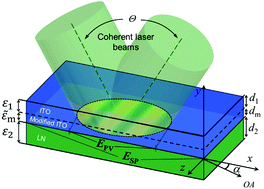Our official English website, www.x-mol.net, welcomes your
feedback! (Note: you will need to create a separate account there.)
Multi-frequency surface plasmons supported with a nanoscale non-uniform 2D electron gas formed due to a polar catastrophe at the oxide interface, dispersions, diffractions, and beyond
Nanoscale ( IF 5.8 ) Pub Date : 2020/03/03 , DOI: 10.1039/c9nr07634d Yingce Wang 1, 2, 3, 4, 5 , Hua Zhao 1, 2, 3, 4, 5 , Chao Wang 1, 2, 3, 4, 5 , Dewang Huo 1, 2, 3, 4, 5 , Hang Su 1, 2, 3, 4, 5 , Xinyan Ma 1, 2, 3, 4, 5 , Jingwen Zhang 1, 2, 3, 4, 5
Nanoscale ( IF 5.8 ) Pub Date : 2020/03/03 , DOI: 10.1039/c9nr07634d Yingce Wang 1, 2, 3, 4, 5 , Hua Zhao 1, 2, 3, 4, 5 , Chao Wang 1, 2, 3, 4, 5 , Dewang Huo 1, 2, 3, 4, 5 , Hang Su 1, 2, 3, 4, 5 , Xinyan Ma 1, 2, 3, 4, 5 , Jingwen Zhang 1, 2, 3, 4, 5
Affiliation

|
Recently, 2D electron gases (2DEGs) formed at oxide interfaces are drawing increasing attention as they cause a myriad of intriguing phenomena. As ideal platforms in supporting surface plasmon polaritons (SPPs) without metallic constituents, such 2DEGs are favorable in non-linear plasmonics for ultra-low total Joule dissipation. Convincingly, an increase in the interfacial electron density (IIED) formed at the interface of indium–tin-oxide and LiNbO3 composite slab is responsible for a number of interesting phenomena, which are hardly explained with the conventional photorefractive theoretical framework but can be satisfactorily elucidated via SPP excitation and resultant colossal non-linear effects. Since the polar-catastrophe-led IIED is universal to all combinations of highly polar ferroelectric oxides (FOs) and less polar transparent conducting oxides (TCOs), a systematic theoretical treatment of an FO/TCO system is pivotal to a variety of promising applications. In this study, the nanometer scale 2DEG at the FO/TCO interface is illustrated theoretically with the Thomas–Fermi screening picture, by taking into account the spontaneous polarization, along with related boundary conditions. The local plasma frequency of 2DEGs can be increased up to the UV regime for the composite slabs discussed, which are suitable for highly desirable visible applications. The SPP dispersion relationship was given for the 2DEG layer sandwiched between the FO slab and the unmodified TCO layer. To further take the non-uniform nature of IIED into account, dramatic dispersions of dielectric permittivity and index of refraction were simulated with a very broad range, hinting at different ways for meeting phase matching conditions and slowing the light for non-linear plasmonic applications, which are confirmed experimentally.
中文翻译:

由于在氧化物界面发生极性突变,分散,衍射等原因而形成的纳米级不均匀二维电子气支撑的多频表面等离子体激元
近来,在氧化物界面处形成的2D电子气(2DEG)引起了越来越多的关注,因为它们引起了许多有趣的现象。作为支持无金属成分的表面等离振子极化子(SPP)的理想平台,此类2DEG在非线性等离激子学中有利于实现超低的总焦耳耗散。令人信服的是,在铟锡氧化物和LiNbO 3复合板的界面上形成的界面电子密度(IIED)的增加引起了许多有趣的现象,这在常规的光折光理论框架中很难解释,但可以令人满意地解决。通过阐明SPP激发和由此产生的巨大非线性效应。由于极性突变导致的IIED对于高极性铁电氧化物(FO)和低极性透明导电氧化物(TCO)的所有组合都是通用的,因此对FO / TCO系统进行系统的理论处理对于多种有希望的应用至关重要。在这项研究中,通过考虑自发极化以及相关的边界条件,利用Thomas-Fermi筛选图片从理论上说明了FO / TCO界面处的纳米级2DEG。对于所讨论的复合板,可以将2DEG的局部等离子体频率提高到紫外线范围,适用于非常理想的可见光应用。给出了夹在FO平板和未改性TCO层之间的2DEG层的SPP色散关系。
更新日期:2020-04-03
中文翻译:

由于在氧化物界面发生极性突变,分散,衍射等原因而形成的纳米级不均匀二维电子气支撑的多频表面等离子体激元
近来,在氧化物界面处形成的2D电子气(2DEG)引起了越来越多的关注,因为它们引起了许多有趣的现象。作为支持无金属成分的表面等离振子极化子(SPP)的理想平台,此类2DEG在非线性等离激子学中有利于实现超低的总焦耳耗散。令人信服的是,在铟锡氧化物和LiNbO 3复合板的界面上形成的界面电子密度(IIED)的增加引起了许多有趣的现象,这在常规的光折光理论框架中很难解释,但可以令人满意地解决。通过阐明SPP激发和由此产生的巨大非线性效应。由于极性突变导致的IIED对于高极性铁电氧化物(FO)和低极性透明导电氧化物(TCO)的所有组合都是通用的,因此对FO / TCO系统进行系统的理论处理对于多种有希望的应用至关重要。在这项研究中,通过考虑自发极化以及相关的边界条件,利用Thomas-Fermi筛选图片从理论上说明了FO / TCO界面处的纳米级2DEG。对于所讨论的复合板,可以将2DEG的局部等离子体频率提高到紫外线范围,适用于非常理想的可见光应用。给出了夹在FO平板和未改性TCO层之间的2DEG层的SPP色散关系。











































 京公网安备 11010802027423号
京公网安备 11010802027423号